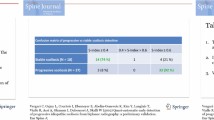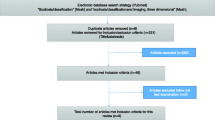Abstract
Adolescent idiopathic scoliosis (AIS) is a complex spinal deformity whose assessment and treatment present many challenges. Computer applications have been developed to assist clinicians. A literature review on computer applications used in AIS evaluation and treatment has been undertaken. The algorithms used, their accuracy and clinical usability were analyzed. Computer applications have been used to create new classifications for AIS based on 2D and 3D features, assess scoliosis severity or risk of progression and assist bracing and surgical treatment. It was found that classification accuracy could be improved using computer algorithms that AIS patient follow-up and screening could be done using surface topography thereby limiting radiation and that bracing and surgical treatment could be optimized using simulations. Yet few computer applications are routinely used in clinics. With the development of 3D imaging and databases, huge amounts of clinical and geometrical data need to be taken into consideration when researching and managing AIS. Computer applications based on advanced algorithms will be able to handle tasks that could otherwise not be done which can possibly improve AIS patients’ management. Clinically oriented applications and evidence that they can improve current care will be required for their integration in the clinical setting.



Similar content being viewed by others
References
Reamy BV, Slakey JB (2001) Adolescent idiopathic scoliosis: review and current concepts. Am Fam Physician 64:111–116
Ajemba PO, Ramirez L, Durdle NG, Hill DL, Raso VJ (2005) A support vectors classifier approach to predicting the risk of progression of adolescent idiopathic scoliosis. IEEE Trans Inf Technol Biomed 9:276–282
Wu H, Ronsky J, Poncet P, Cheriet F, Xue D, Harder J, Zernicke R (2005) Prediction of scoliosis progression in time series using a hybrid learning technique. Conf Proc IEEE Eng Med Biol Soc 6:6452–6455
Villemure I, Aubin CE, Grimard G, Dansereau J, Labelle H (2001) Progression of vertebral and spinal three-dimensional deformities in adolescent idiopathic scoliosis: a longitudinal study. Spine 26:2244–2250
Lonstein JE, Carlson JM (1984) The prediction of curve progression in untreated idiopathic scoliosis during growth. J Bone Joint Surg 66:1061–1071
Goldberg MS, Poitras B, Mayo NE, Labelle H, Bourassa R, Cloutier R (1988) Observer variation in assessing spinal curvature and skeletal development in adolescent idiopathic scoliosis. Spine 13:1371–1377
Morrissy RT, Goldsmith GS, Hall EC, Kehl D, Cowie GH (1990) Measurement of the Cobb angle on radiographs of patients who have scoliosis. Evaluation of intrinsic error. J Bone Joint Surg 72:320–327
Beauchamp M, Labelle H, Grimard G, Stanciu C, Poitras B, Dansereau J (1993) Diurnal variation of Cobb angle measurement in adolescent idiopathic scoliosis. Spine 18:1581–1583
King HA, Moe JH, Bradford DS, Winter RB (1983) The selection of fusion levels in thoracic idiopathic scoliosis. J Bone Joint Surg 65:1302–1313
Lenke LG, Betz RR, Harms J, Bridwell KH, Clements DH, Lowe TG, Blanke K (2001) Adolescent idiopathic scoliosis: a new classification to determine extent of spinal arthrodesis. J Bone Joint Surg 83-A:1169–1181
Richards BS, Sucato DJ, Konigsberg DE, Ouellet JA (2003) Comparison of reliability between the Lenke and King classification systems for adolescent idiopathic scoliosis using radiographs that were not premeasured. Spine 28:1148–1156 discussion 1156–1157
Lenke LG, Betz RR, Clements D, Merola A, Haher T, Lowe T, Newton P, Bridwell KH, Blanke K (2002) Curve prevalence of a new classification of operative adolescent idiopathic scoliosis: does classification correlate with treatment? Spine 27:604–611
Aubin CE, Labelle H, Ciolofan OC (2007) Variability of spinal instrumentation configurations in adolescent idiopathic scoliosis. Eur Spine J 16:57–64
Robitaille M, Aubin CE, Labelle H (2007) Intra and interobserver variability of preoperative planning for surgical instrumentation in adolescent idiopathic scoliosis. Eur Spine J 16:1604–1614. doi:10.1007/s00586-007-0431-x
Tang F-h, Chan LWC, Lau H-p, Tsui P-y, Cheung C-w (2008) Computer-generated index for evaluation of idiopathic scoliosis in digital chest images: a comparison with digital measurement. J Dig Imag Offic J Soc Comput Appl Radiol 21 Suppl 1:S113–S120. doi:10.1007/s10278-007-9050-7
Greenspan A, Pugh JW, Norman A, Norman RS (1978) Scoliotic index: a comparative evaluation of methods for the measurement of scoliosis. Bull Hosp Joint Dis 39:117–125
Jaremko JL, Poncet P, Ronsky J, Harder J, Dansereau J, Labelle H, Zernicke RF (2002) Comparison of Cobb angles measured manually, calculated from 3-D spinal reconstruction, and estimated from torso asymmetry. Comput Methods Biomech Biomed Eng 5:277–281
Jaremko JL, Poncet P, Ronsky J, Harder J, Dansereau J, Labelle H, Zernicke RF (2002) Genetic algorithm-neural network estimation of Cobb angle from torso asymmetry in scoliosis. J Biomech Eng 124:496–503
Jaremko JL, Poncet P, Ronsky J, Harder J, Dansereau J, Labelle H, Zernicke RF (2001) Estimation of spinal deformity in scoliosis from torso surface cross sections. Spine 26:1583–1591
Baxt W (1995) Application of artificial neural networks to clinical medicine. Lancet 346:1075–1079
Ramirez L, Durdle NG, Raso VJ, Hill DL (2006) A support vector machines classifier to assess the severity of idiopathic scoliosis from surface topography. IEEE Trans Inf Technol Biomed 10:84–91
Noble WS (2006) What is a support vector machine? Nat Biotechnol 24:1565–1567. doi:10.1038/nbt1206-1565
Lenke LG, Betz RR, Haher TR, Lapp MA, Merola AA, Harms J, Shufflebarger HL (2001) Multisurgeon assessment of surgical decision-making in adolescent idiopathic scoliosis: curve classification, operative approach, and fusion levels. Spine 26:2347–2353
Cummings RJ, Loveless EA, Campbell J, Samelson S, Mazur JM (1998) Interobserver reliability and intraobserver reproducibility of the system of King et al. for the classification of adolescent idiopathic scoliosis. J Bone Joint Surg 80:1107–1111
Lenke LG, Betz RR, Bridwell KH, Clements DH, Harms J, Lowe TG, Shufflebarger HL (1998) Intraobserver and interobserver reliability of the classification of thoracic adolescent idiopathic scoliosis. J Bone Joint Surg 80:1097–1106
Stokes IA, Aronsson DD (2002) Identifying sources of variability in scoliosis classification using a rule-based automated algorithm. Spine 27:2801–2805
Stokes IA, Aronsson DD (2002) Rule-based algorithm for automated King-type classification of idiopathic scoliosis. Stud Health Technol Inform 88:149–152
Stokes IA, Aronsson DD (2006) Computer-assisted algorithms improve reliability of King classification and Cobb angle measurement of scoliosis. Spine 31:665–670
Phan P, Mezghani N, Nault ML, Aubin CE, Parent S, de Guise J, Labelle H (2010) A decision tree can increase accuracy when assessing curve types according to Lenke classification of adolescent idiopathic scoliosis. Spine (Phila Pa 1976) 35:1054–1059. doi:10.1097/BRS.0b013e3181bf280e
Mezghani N, Chav R, Humbert L, Parent S (2008) A computer-based classifier of three-dimensional spinal scoliosis severity. Int J Comput Assist Radiol Surg 3:55–60. doi:10.1007/s11548-008-0163-3
Poncet P, Dansereau J, Labelle H (2001) Geometric torsion in idiopathic scoliosis: three-dimensional analysis and proposal for a new classification. Spine 26:2235–2243
Sangole A, Aubin C, Labelle H, Stokes I, Lenke L, Jackson R, Newton P (2009) Three-dimensional classification of thoracic scoliotic curves. Spine 34:91–99. doi:10.1097/BRS.0b013e3181877bbb
Stokes I, Sangole A, Aubin C (2009) Classification of scoliosis deformity three-dimensional spinal shape by cluster analysis. Spine 34:584–590. doi:10.1097/BRS.0b013e318190b914
Duong L, Cheriet F, Labelle H (2006) Three-dimensional classification of spinal deformities using fuzzy clustering. Spine 31:923–930
Duong L, Mac-Thiong J, Cheriet F, Labelle H (2009) Three-dimensional subclassification of Lenke type 1 scoliotic curves. J Spinal Disord Tech 22:135–143. doi:10.1097/BSD.0b013e31816845bc
Parent S, Newton PO, Wenger DR (2005) Adolescent idiopathic scoliosis: etiology, anatomy, natural history, and bracing. Instr Course Lect 54:529–536
Kessler JI (2008) Efficacy of a new computer-aided design/computer-aided manufacture orthosis in the treatment of adolescent idiopathic scoliosis. J Pediatr Orthop B 17:207–211. doi:10.1097/BPB.0b013e3283046117
Labelle H, Bellefleur C, Joncas J, Aubin C, Cheriet F (2007) Preliminary evaluation of a computer-assisted tool for the design and adjustment of braces in idiopathic scoliosis: a prospective and randomized study. Spine 32:835–843. doi:10.1097/01.brs.0000259811.58372.87
Wong M, Cheng J, Lo K (2005) A comparison of treatment effectiveness between the CAD/CAM method and the manual method for managing adolescent idiopathic scoliosis. Prosthet Orthot Int 29:105–111
Wong M, Cheng J, Wong M, So S (2005) A work study of the CAD/CAM method and conventional manual method in the fabrication of spinal orthoses for patients with adolescent idiopathic scoliosis. Prosthet Orthot Int 29:93–104
Perie D, Aubin C, Petit Y, Beausejour M, Dansereau J, Labelle H (2003) Boston brace correction in idiopathic scoliosis: a biomechanical study. Spine 28:1672–1677. doi:10.1097/01.BRS.0000083165.93936.6D
Perie D, Aubin CE, Petit Y, Labelle H, Dansereau J (2004) Personalized biomechanical simulations of orthotic treatment in idiopathic scoliosis. Clin Biomech (Bristol, Avon) 19:190–195. doi:10.1016/j.clinbiomech.2003.11.003
Clin J, Aubin CE, Labelle H (2007) Virtual prototyping of a brace design for the correction of scoliotic deformities. Med Biol Eng Comput 45:467–473. doi:10.1007/s11517-007-0171-4
Clin J, Aubin CE, Parent S, Sangole A, Labelle H (2010) Comparison of the biomechanical 3D efficiency of different brace designs for the treatment of scoliosis using a finite element model. Eur Spine J. doi:10.1007/s00586-009-1268-2
Katz DE, Herring JA, Browne RH, Kelly DM, Birch JG (2010) Brace wear control of curve progression in adolescent idiopathic scoliosis. J Bone Joint Surg Am 92:1343–1352. doi:10.2106/JBJS.I.01142
Rahman T, Bowen JR, Takemitsu M, Scott C (2005) The association between brace compliance and outcome for patients with idiopathic scoliosis. J Pediatr Orthop 25:420–422
Lou E, Hill D, Raso J, Moreau M, Mahood J (2005) Smart orthosis for the treatment of adolescent idiopathic scoliosis. Med Biol Eng Comput 43:746–750
Nault ML, Labelle H, Aubin CE, Balazinski M (2007) The use of fuzzy logic to select which curves need to be instrumented and fused in adolescent idiopathic scoliosis: a feasibility study. J Spinal Disord Tech 20:594–603
Nault ML, Labelle H, Aubin CE, Sangole A, Balazinski M (2009) Fuzzy-logic-assisted surgical planning in adolescent idiopathic scoliosis. J Spinal Disord Tech 22:263–269. doi:10.1097/BSD.0b013e3181761950
Torres A, Nieto JJ (2006) Fuzzy logic in medicine and bioinformatics. J Biomed Biotechnol 2006:91908. doi:10.1155/JBB/2006/91908
Stokes IA, Gardner-Morse M (1993) Three-dimensional simulation of Harrington distraction instrumentation for surgical correction of scoliosis. Spine 18:2457–2464
Gardner-Morse M, Stokes IA (1994) Three-dimensional simulations of the scoliosis derotation maneuver with Cotrel-Dubousset instrumentation. J Biomech 27:177–181
Gréalou L, Aubin CE, Labelle H (2000) Biomechanical modeling of the C-D instrumentation in scoliosis: a study of correction mechanisms. Arch Physiol Biochem 108(1–2):194
Robitaille M, Aubin CE, Labelle H (2009) Effects of alternative instrumentation strategies in adolescent idiopathic scoliosis: a biomechanical analysis. J Orthop Res 27:104–113. doi:10.1002/jor.20654
Aubin CE, Petit Y, Stokes IA, Poulin F, Gardner-Morse M, Labelle H (2003) Biomechanical modeling of posterior instrumentation of the scoliotic spine. Comput Methods Biomech Biomed Engin 6:27–32. doi:10.1080/1025584031
Desroches G, Aubin CE, Sucato DJ, Rivard CH (2007) Simulation of an anterior spine instrumentation in adolescent idiopathic scoliosis using a flexible multi-body model. Med Biol Eng Comput 45:759–768
Robitaille M, Aubin CE, Labelle H (2006) Biomechanical assessment of variable instrumentation strategies in adolescent idiopathic scoliosis: preliminary analysis of 3 patients and 6 scenarios. Stud Health Technol Inform 123:309–314
Aubin CE, Labelle H, Chevrefils C, Desroches G, Clin J, Eng AB (2008) Preoperative planning simulator for spinal deformity surgeries. Spine (Phila Pa 1976) 33:2143–2152. doi:10.1097/BRS.0b013e31817bd89f
Delorme S, Petit Y, de Guise JA, Labelle H, Aubin CE, Dansereau J (2003) Assessment of the 3-D reconstruction and high-resolution geometrical modeling of the human skeletal trunk from 2-D radiographic images. IEEE Trans Biomed Eng 50:989–998
Majdouline Y, Aubin C-E, Sangole A, Labelle H (2009) Computer simulation for the optimization of instrumentation strategies in adolescent idiopathic scoliosis. Med Biol Eng Comput 47:1143–1154. doi:10.1007/s11517-009-0509-1
Wu H, Ronsky J, Cheriet F, Harder J, Zernicke R (2006) Scoliotic progression patterns in prognostic factors and future prediction of spinal deformity progression. Stud Health Technol Inform 123:40–46
Arlet V, Shilt J, Bersusky E, Abel M (2008) Experience with an online prospective database on adolescent idiopathic scoliosis: development and implementation. Eur Spine J 17(11):1497–1506
Acknowledgments
Federal funds were received in support of this work. No benefits in any form have been or will be received from a commercial party related directly or indirectly to the subject of this manuscript. Supported by the Fonds de la Recherche en santé du Québec and MENTOR, a strategic training program of the Canadian Institutes of Health Research.
Conflict of interest
None.
Author information
Authors and Affiliations
Corresponding author
Rights and permissions
About this article
Cite this article
Phan, P., Mezghani, N., Aubin, CÉ. et al. Computer algorithms and applications used to assist the evaluation and treatment of adolescent idiopathic scoliosis: a review of published articles 2000–2009. Eur Spine J 20, 1058–1068 (2011). https://doi.org/10.1007/s00586-011-1699-4
Received:
Revised:
Accepted:
Published:
Issue Date:
DOI: https://doi.org/10.1007/s00586-011-1699-4




